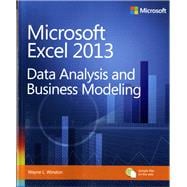Master business modeling and analysis techniques with Microsoft Excel 2013, and transform data into bottom-line results. Written by award-winning educator Wayne Winston, this hands-on, scenario-focused guide shows you how to use the latest Excel tools to integrate data from multiple tables—and how to effectively build a relational data source inside an Excel workbook.
Solve real business problems with Excel—and sharpen your edge
- Summarize data with PivotTables and Descriptive Statistics
- Explore new trends in predictive and prescriptive analytics
- Use Excel Trend Curves, multiple regression, and exponential smoothing
- Master advanced Excel functions such as OFFSET and INDIRECT
- Delve into key financial, statistical, and time functions
- Make your charts more effective with the Power View tool
- Tame complex optimization problems with Excel Solver
- Run Monte Carlo simulations on stock prices and bidding models
- Apply important modeling tools such as the Inquire add-in








